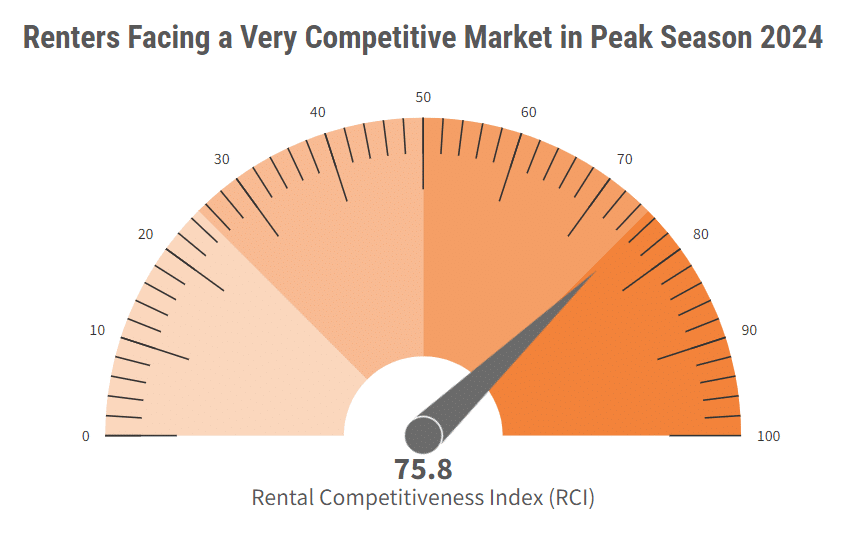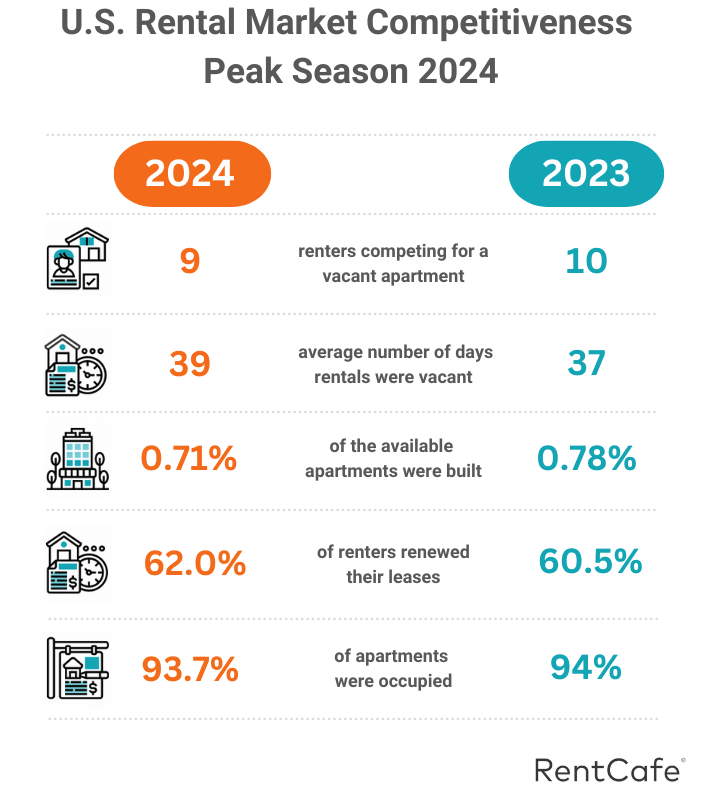A new report from RentCafe has ranked the nation’s best markets for rentals. The report found that the Midwest’s transformation to a leading area in tech and manufacturing is attracting budget—renters seeking affordability, amenities, and nature.
This trend has propelled suburban Chicago to the top of the list of nation’s hottest rental markets, unseating the Miami region which long held its dominance atop the U.S. rental market.
For the study, RentCafe analyzed five metrics in terms of rental competitiveness:
- The number of days apartments were vacant
- The percentage of apartments occupied by renters
- The number of prospective renters competing for an apartment
- The percentage of renters who renewed their leases
- The share of new apartments completed recently
Based upon these metrics, RentCafe developed a Rental Competitiveness Index (RCI) during the busiest time for moving. The national RCI score is currently 75.8, meaning that the apartment market in the U.S. overall is very competitive in peak rental season.

Vacancies Abound
There has been a surge of late in the number of new apartments available, as approximately 30% of the 137 markets analyzed exhibited signs of softening compared to last year’s peak rental season. RentCafe found that the overall occupancy rate has slightly decreased to 93.7%, down from 94% one year ago. At the same time, vacant apartments stay on the market for an average of 39 days, two days longer than just a year ago, and there are slightly fewer renters competing for each available unit (nine now compared to 10 last summer).

Regional Analysis
The Northeast led all other U.S. regions with an RCI score of 80.4, followed by the Midwest with a score of 80. The Mid-Atlantic region ranked third with an RCI score of 78.4, followed by the South with an RCI score of 76.7, the Southeast with an RCI score of 73; the West with an RCI score of 72.9; the Southwest with an RCI score of 72.6; and the Pacific Northwest which had the lowest RCI score at 70.6 during peak rental season.
Why the Windy City?
Suburban Chicago’s rise atop RentCafe’s rankings was fueled by a combination of factors linked to the heartland’s growing economy that make the metro area highly desirable for renters, yet extremely challenging for those looking for apartments. Close proximity to the Windy City’s job market and attractions have made Chicago areas like Naperville, Schaumburg, Oak Brook, Evanston, Deerfield, Arlington Heights, Glenview, Barrington, and Wheaton prime locations for those looking for rentals.
In these areas, vacant units were typically leased within 33 days (almost one week faster than the national benchmark), and each available apartment attracted 16 hopeful renters, on average according to RentCafe. The area’s appeal was fueled by a recent surge in corporate relocations and expansions, which has helped Chicago make an impressive jump of 11 spots—up from 16th place just a year ago.
Demand for the area has outpaced the supply of available units for rent, as Chicago reported a modest increase of 0.52% in new apartments, while more apartment-dwellers chose to renew their leases during the peak rental season (58.7%, up from 57.5% one year ago), which contributed to an overall occupancy rate of 94.7%. Typically, vacant apartments in Chicago are filled within a month, with 14 prospective renters competing for each available unit.
Miami Remains Close
Miami’s reign as the hottest rental market is hanging by a thread, reporting year-over-year declines in nearly all competitiveness metrics—except for the share of new units built. Despite Miami’s housing supply having grown by 1.02% in recent months, this increase is still less than half of the new apartments that opened at the same time last year. Even with this input of new apartments, 71.5% of those already renting chose to renew their leases this busy summer (down from 73% this time last year).
Rounding Out the Top Markets
Milwaukee ranked the third-most competitive rental market this peak season with an RCI score of 90.7, attracting young professionals and entrepreneurs seeking career opportunities in manufacturing, tech, and healthcare. The high demand for apartments in the Milwaukee region drove nearly 70% of existing renters to renew their leases during the moving frenzy, resulting in an occupancy rate of 95.5%. Newly built rentals represented just 0.36% of the metro’s housing supply.
Coming in fourth, the Connecticut region of Bridgeport-New Haven boasted an RCI score of 85.8, moving up from eighth place in peak season 2023. The Bridgeport-New Haven metro area is close to opportunities and attractions in New York City, however, with no new apartments opened recently in this supply-constrained area, 61.8% of those already renting in Bridgeport-New Haven have decided to stay put during the moving frenzy, which drove the metro’s occupancy rate to a high 95.6%.
Click here for more on RentCafe’s hottest rental markets.
The post Renters Find a New Destination for Affordability first appeared on The MortgagePoint.





















